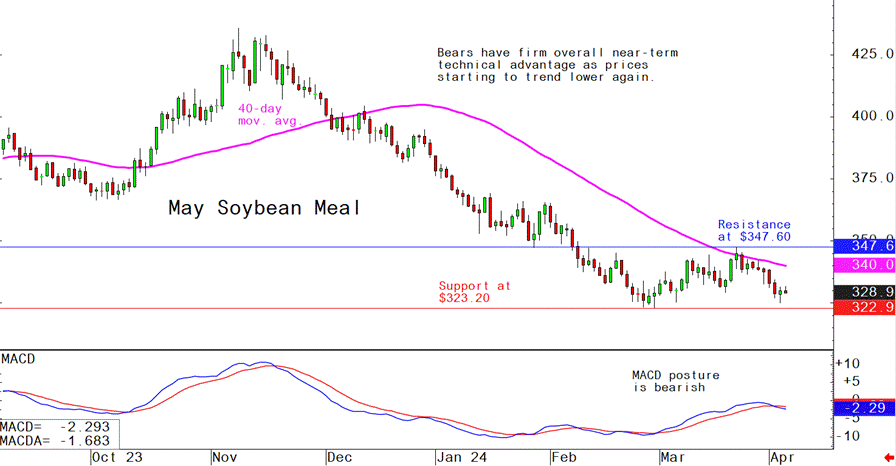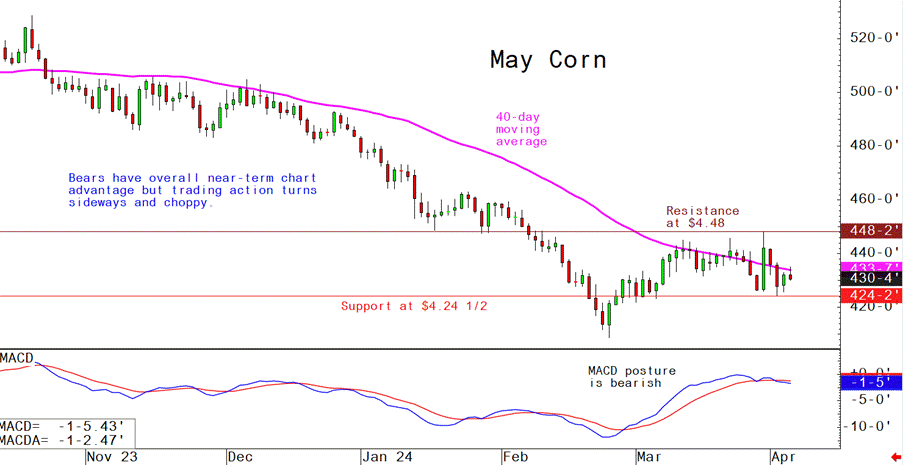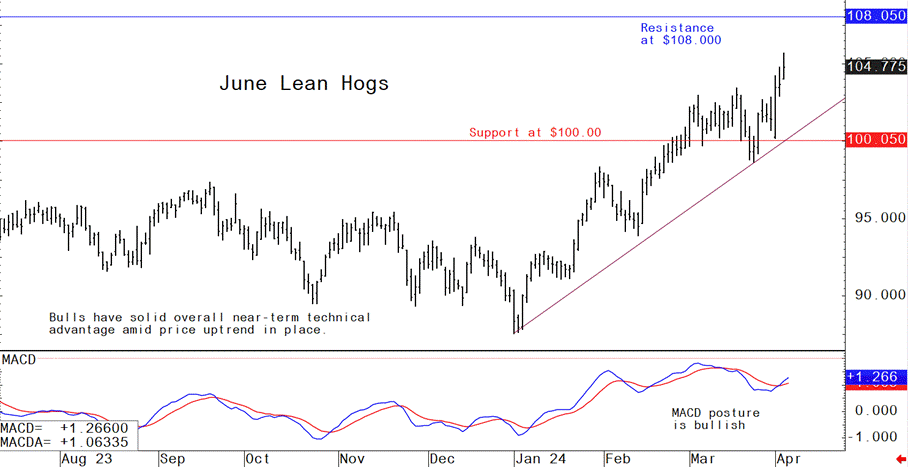



Pig outlook - Lean hog futures bulls are snorting
Livestock analyst Jim Wyckoff reports on global pig newsJune lean hog futures surged to new contract highs this week. The technical are fully bullish to suggest more upside in the near term. The resilience that lean hog futures have shown in the face of heavy selling in the cattle market is a testament to the present strength of the hog market. The latest CME cash hog index is $84.92 (as of April 1), while the preliminary calculation puts the index up another 23 cents to $85.15 for today. After surging to a fresh for-the-move high Tuesday, wholesale pork prices slipped Wednesday. But movement of fresh pork has been good. While movement improved to 274.6 loads Wednesday, retailer buying has been tepid, suggesting they are being selective buyers with the cutout in the mid- to upper-$90.00 range.
Weekly USDA US beef, pork export sales
Beef: Net sales of 18,700 MT for 2024 were up 48 percent from the previous week and 53 percent from the prior 4-week average. Increases were primarily for South Korea (6,100 MT, including decreases of 400 MT), Japan (5,000 MT, including decreases of 500 MT), Canada (1,700 MT), Taiwan (1,500 MT, including decreases of 100 MT), and Mexico (1,400 MT, including decreases of 200 MT). Exports of 13,300 MT were down 5 percent from the previous week and 12 percent from the prior 4-week average. The destinations were primarily to South Korea (3,800 MT), Japan (3,300 MT), China (2,500 MT), Mexico (1,100 MT), and Taiwan (1,000 MT).
Pork: Net sales of 28,700 MT for 2024 were down 48 percent from the previous week and 24 percent from the prior 4-week average. Increases primarily for Mexico (23,000 MT, including decreases of 500 MT), South Korea (3,000 MT, including decreases of 200 MT), Canada (1,200 MT, including decreases of 600 MT), Costa Rica (1,000 MT), and China (800 MT, including decreases of 100 MT), were offset by reductions for Australia (3,900 MT) and Japan (600 MT). Exports of 34,900 MT were up 2 percent from the previous week and 5 percent from the prior 4-week average. The destinations were primarily to Mexico (11,600 MT), South Korea (5,900 MT), Japan (4,600 MT), China (3,600 MT), and Canada (2,000 MT).
Pork exports boost corn and soybean industries in US: Study
Beef and pork exports have a significant impact on the corn and soybean industries in the United States, according to a study conducted by The Juday Group and released by the U.S. Meat Export Federation (USMEF). In 2023, beef and pork exports amounted to $18.1 billion, contributing substantially to the value of corn and soybeans nationally and on a state level in leading corn and soybean-producing states.
According to the study:
- Nationally, beef and pork exports contributed an estimated total economic impact of 14.6% per bushel to the value of corn and 13.9% per bushel to soybeans in 2023.
- Beef and pork exports accounted for 512.7 million bushels of U.S. corn usage, with a market value of $3.05 billion.
- Beef and pork exports also contributed to the usage of distiller’s dried grains with solubles (DDGS), totaling 3.07 million tonnes and equating to $671.62 million.
- Pork exports accounted for 96.8 million bushels of U.S. soybean usage, valued at $1.36 billion.
These exports had a significant economic impact, contributing to the overall value of corn and soybeans in the market. Additionally, the quality of U.S. corn and soybeans as feed inputs was highlighted as a key differentiator for U.S. red meat in international markets, emphasizing the importance of sustainable production practices and feed processing efficiencies.
A person in Texas was diagnosed with bird flu, the second human case linked to infected dairy cattle in recent weeks. The patient's only symptom was eye inflammation, and they are being treated oseltamivir, the antiviral drug sold by Roche as Tamiflu. The risk to the general public is considered low, but close contact with infected birds or animals increases the risk of infection.
The virus has spread among dairy herds in Texas, Kansas, Michigan, Idaho, and New Mexico, suggesting potential cow-to-cow transmission.
There are concerns among epidemiologists about the virus evolving to spread more easily among humans, although there is currently no evidence of this. USDA has not identified changes to the virus that would make it more transmissible to humans.
Texas officials are providing guidance to affected dairies on minimizing exposure and monitoring for flu-like symptoms among workers.
USDA Pig Report: Negative compared to expectations
USDA’s Hogs & Pigs Report last Thursday showed nearly all categories above the average pre-report estimates. USDA estimated the March 1 hog herd up 0.6% from year-ago, with the market hog inventory 0.8% bigger while the breeding herd declined 2.1%. The winter pig crop increased 1.9%. While winter farrowings declined 2.6%, litter size jumped 4.6% to a record 11.53 head.
Focus of the debate in food industry is shifting from plant-based products to lab-grown meat
Several US states (including Alabama, Arizona, Florida and Tennessee) consider legislation to outlaw this protein source. Arguments in favor of the ban cite safety concerns and the impact on traditional ranching, while opponents view such measures as protectionist and advocate for consumer choice.
Lab-grown meat, produced using cells from living animals in bioreactors, has attracted significant investment from startups and traditional producers like Cargill and Tyson. While some argue that it offers environmental benefits and addresses sustainability challenges, others raise questions about its acceptance by consumers, nutritional equivalence, environmental impact, and safety standards.
Groups sue FDA over ractopamine use in farm animals
Several organizations including the Animal Legal Defense Fund, Center for Biological Diversity, Center for Food Safety, and Food Animal Concerns Trust have filed a lawsuit against the U.S. Food and Drug Administration (FDA) demanding a response to their rulemaking petitions regarding the use of ractopamine in farm animals. Ractopamine is a feed additive approved for use in pigs and beef cattle in the U.S. but is banned in many international markets due to concerns about its effects on human health and the environment. The plaintiffs seek a substantive response to their petitions, which urge for the reduction or elimination of ractopamine in farmed animals. They argue that the FDA's failure to provide final decisions on these petitions violates the Administrative Procedure Act, which requires federal agencies to decide on rulemaking petitions within a reasonable period.
The groups cite evidence linking ractopamine to various health and environmental issues, including heart and respiratory problems in meat consumers and farm workers, increased risk of pathogen contagion, and environmental pollution through seepage and runoff into water sources.
Despite previous legal challenges to the approval of ractopamine, which were largely dismissed on procedural grounds, the organizations are pushing for action from the FDA to address what they see as significant risks associated with the use of this feed additive.
Some major U.S. pork producers, including Hormel Foods, Tyson Fresh Meats, JBS USA, and Smithfield Foods, have voluntarily stopped using ractopamine in pig diets, potentially to expand export opportunities to markets where the additive is banned.
The next week’s likely high-low price trading ranges:
June lean hog futures--$102.00 to 108.00 and with a sideways-higher bias
May soybean meal futures--$323.20 to $340.00, and with a sideways bias
May corn futures--$4.20 to $4.45 and a sideways bias
Latest analytical daily charts lean hog, soybean meal and corn futures










